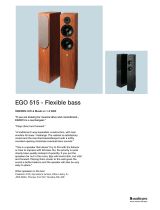
8
Overview:
Amongst other things, the Make Noise Wogglebug contains the following: 1 Voltage-Controlled Clock, 1 Sample & Hold, 2 Lag
Processors, 1 Random Gate Burst Generator, and 2 VCO Digital Ring Mod: most of which are patchable via the instrument's panel
in a system that is capable of CV and Audio Signal generation and processing.
While we have broken the Panel Controls & I/O description into Sections for explanation, please understand that ALL portions of
the Wogglebug interact with each other. For example, changing the Ego/Id Balance will aect the Stepped, SMOOTH, and
Woggle CVs, the SMOOTH VCO, Ring-Mod and Woggle VCO OUTs! The way that we like to think of the system is that the Woggle
Circuit is chasing the SMOOTH/Stepped Circuit, which is being kicked in the ass by the Internal Clock. It is very possible to make
patches and panel settings which lock up the Wogglebug, and thus the CV outputs will hang at the last voltage level while the
VCOs will drone on almost unchanging. When this happens, adjusting just about any panel control will disturb and wake the
Wogglebug. Finally, consider that many changes in the system are NOT immediate. This is because the Wogglebug is a complex
feedback system where several sub-circuits are responding to each other.
IS THE WOGGLEBUG MY SYNTHESIZER'S ID MONSTER? SHOULD I BEWARE OF THE WOGGLEBUG? YES and maybe.
The Wogglebug is a random voltage generator, originally designed by Grant Richter of Wiard Synthesizers. The Wogglebug's
purpose is to overtake the control voltages produced by your keyboard or sequencer during performance and give a voice to
your synthesizer's ID. It is your synthesizer's ID MONSTER. A continuation of the Smooth and Stepped, uctuating, Random
Voltage Sources, pioneered by Don Buchla, the core of the circuit is based on the Buchla Model 265 "Source of Uncertainty"
module, which many consider to be the most musical of all random voltage generators. Like the 265, the Wogglebug utilizes a
lag processor (low frequency smoothing lter), a VCO, and a Sample & Hold in order to produce Stepped and Smooth (or lagged,
slewed) Control Voltages in the range of 0 to 10 volts.
Grant's Wogglebug design expands on this system to include the otherworldly Woggle CVs (stepped voltages with decaying
sinusoids at the edges), which must be heard in action to be truly appreciated. In a moment of considerable noise, Richter
decided to tap into the sound sources at the uncertainly beating heart of the Wogglebug and bring them forth to the
instrument's panel. He then gured a clever way to Ring Modulate these sounds and that too is on the panel of all Wogglebugs.
Thus, the Wogglebug is a complete system: no external modules are required to Woggle; however, all voltage-controlled systems
long to be tickled, bitten, plagued, and eventually, destroyed by the Wogglebug.
Tony fell in love with Grant's #3 circuit the moment his rst Wogglebug came to life on an experimenter's breadboard. He built a
few DIY Wogglebug #3, including the Ryan Williams designed clone PCB and was lucky enough to have used the Wiard
Wogglebug #5 extensively. Now, we at Make Noise feel honored to be presenting this circuit as a Make Noise module.
The Make Noise Wogglebug is neither version #3 nor #5. In the truest spirit of Grant Richter, the Make Noise Wogglebug is not a
clone. Instead, it is a tribute to all that Woggles and is an evolution of the original Richter design. Like the #3, the Make Noise
Wogglebug is a single system; however, it improves upon the #3 by oering further functionality, such as an Inuence Input to
the Ring Mod circuit, the ability to directly inject a signal to the heart of the Wogglebug via the Ego Input, and a Random Gate
Burst function: all of which have never appeared on any other Wogglebug. We also redesigned the Cluster circuit, and thus it has
been renamed as Ego/Id Balance to reect its further purposes, allowing for new functionality that has again, never existed with
any other Wogglebug.
























